重庆医科大学:《诊断学》课程教学资源(授课教案)10 发热
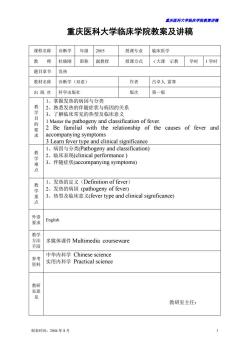
重庆医科大半随床半院载寒沙精 重庆医科大学临床学院教案及讲稿 课程名称诊断学年级2005 授课专业临床医学 教师杜晓刚职称副教授 授课方式 √大课示教学时1学时 题目章节发热 教材名称诊断学(双语) 作者 吕卓人雷寒 出版社 科学出版社 版次 第一版 、握发热的病因5分类 2、熟悉发热的伴随症状与病因的关系 3、了解临床常见的热型及临床意义 目的要求 relationship of the causes of fever and accompanying symptoms 3 Learn fever type and clinical significance 、病因与分类Pathogeny and classification) 教学难点 2、临床表现(clinical performance) 3、伴随症状(accompanying symptoms) 发热的定义(Definition of fever 教学 2、发热的病因(pathogeny of fever) 重点 3、热型及临床意义(fever type and clinical significance) 外语 要求 English 教学 方法 多媒体课件Multimedia courseware 手段 参考 中华内科学Chinese science 资料 实用内科学Practical science 教研 见 教研室主任: 制表时间:2004年8月
重庆医科大学临床学院教案讲稿 制表时间:2004 年 8 月 1 重庆医科大学临床学院教案及讲稿 课程名称 诊断学 年级 2005 授课专业 临床医学 教 师 杜晓刚 职称 副教授 授课方式 √大课 示教 学时 1 学时 题目章节 发热 教材名称 诊断学(双语) 作者 吕卓人 雷寒 出 版 社 科学出版社 版次 第一版 教 学 目 的 要 求 1、掌握发热的病因与分类 2、熟悉发热的伴随症状与病因的关系 3、了解临床常见的热型及临床意义 1 Master the pathogeny and classification of fever. 2 Be familial with the relationship of the causes of fever and accompanying symptoms 3 Learn fever type and clinical significance 教 学 难 点 1、病因与分类(Pathogeny and classification) 2、临床表现(clinical performance ) 3、伴随症状(accompanying symptoms) 教 学 重 点 1、发热的定义(Definition of fever) 2、发热的病因 (pathogeny of fever) 3、热型及临床意义(fever type and clinical significance) 外语 要求 English 教学 方法 手段 多媒体课件 Multimedia courseware 参考 资料 中华内科学 Chinese science 实用内科学 Practical science 教研 室意 见 教研室主任:
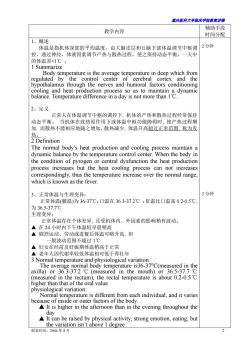
重庆医科大学脑床学院载讲满 辅助手段 教学内容 时间分配 1、概述 体温是指机体深部的平均温度,由大脑皮层和丘脑下部体温调节中枢调 2分钟 控,通过神经、体液因素调节产热与散热过程,使之保持动态平衡,一天中 的体温差<1℃ 1 Summarize hypothalamus through the nerves and humoral factors conditioning cooling and heat production process so as to maintain a dynamic balance.Temperature difference in a day is not more than 1C. 2、定义 正常人在体温调节中枢的调控下,机体的产热和散热过程经常保持 动态平衡。 当机体在致热原作用下或体温中枢功能障碍时 使产执过程 加,而散热不能相应地随之增加,散热减少,体温升高超过正常范围。称为发 热 2 Definition The normal body's heat production and cooling process maintain a dynamic balance by the temperature control center.When the body in the condition of pyrogenr centra I dysfunction the heat production process increases but the heat cooling process can not increases correspondingly,thus the temperature increase over the normal range, which is known as the fever. 3、正常体温与生理变异: 3分钟 正常体温(腋温)为36-37℃:口温在36.3-37.2℃:肛温比口温高0.2-0.5℃ 为36.5-37.7℃ 生理变异: 正常体温存在个体差异,且受机体内、外因素的影响稍有波动 ▲在24小时内下午体温较早晨稍高 ▲剧烈运动、劳动或进餐后体温可略升高,但 般波动范围不超过1℃ ▲妇女在经前及妊娠期体温稍高于正常 ▲老年人因代谢率较低体温相对低于青壮年 3 No o ogical t axilla)or 3637 ℃ -37C(meas in the nouth) measured in the the rectal temperat is about0.2-0.5℃ higher than that of the oral value. perature is different from each individual and it varies A It is higher in the afternoon than in the evening throughout the A It can be raised by physical activity,strong emotion,eating,but the variation isn't above 1 degree 制表时间:2004年8月
重庆医科大学临床学院教案讲稿 制表时间:2004 年 8 月 2 教学内容 辅助手段 时间分配 1、概述 体温是指机体深部的平均温度,由大脑皮层和丘脑下部体温调节中枢调 控,通过神经、体液因素调节产热与散热过程,使之保持动态平衡,一天中 的体温差<1℃ 。 1 Summarize Body temperature is the average temperature in deep which from regulated by the control center of cerebral cortex and the hypothalamus through the nerves and humoral factors conditioning cooling and heat production process so as to maintain a dynamic balance. Temperature difference in a day is not more than 1℃. 2、定义 正常人在体温调节中枢的调控下, 机体的产热和散热过程经常保持 动态平衡。 当机体在致热原作用下或体温中枢功能障碍时, 使产热过程增 加, 而散热不能相应地随之增加,散热减少, 体温升高超过正常范围, 称为发 热。 2 Definition The normal body's heat production and cooling process maintain a dynamic balance by the temperature control center. When the body in the condition of pyrogen or central dysfunction the heat production process increases but the heat cooling process can not increases correspondingly, thus the temperature increase over the normal range, which is known as the fever. 3、正常体温与生理变异: 正常体温(腋温)为 36-37℃;口温在 36.3-37.2℃ ;肛温比口温高 0.2-0.5℃, 为 36.5-37.7℃ 生理变异: 正常体温存在个体差异, 且受机体内、外因素的影响稍有波动。 ▲ 在 24 小时内下午体温较早晨稍高 ▲ 剧烈运动、劳动或进餐后体温可略升高, 但 一般波动范围不超过 1℃ ▲ 妇女在经前及妊娠期体温稍高于正常 ▲ 老年人因代谢率较低体温相对低于青壮年 3 Normal temperature and physiological variation: The average normal body temperature is36-37°C(measured in the axilla) or 36.3-37.2 ℃ (measured in the mouth) or 36.5-37.7 ℃ (measured in the rectum), the rectal temperature is about 0.2-0.5℃ higher than that of the oral value. physiological variation: Normal temperature is different from each individual, and it varies because of inside or outer factors of the body. ▲ It is higher in the afternoon than in the evening throughout the day ▲ It can be raised by physical activity, strong emotion, eating, but the variation isn’t above 1 degree 2 分钟 3 分钟
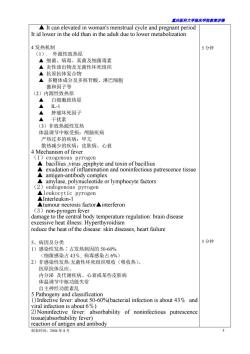
重庆医科大学临床学院载案讲满 A It can elevated in woman's menstrual cycle and pregnant period It id lower in the old than in the adult due to lower metabolizatio 4发热机制 5分针 (1) 外源性致热原 ▲细菌、病毒、真菌及细菌毒素 ▲炎性途出物及天菌性坏死细纠 抗原抗体复合物 ▲ 多糖体成分及多核苷酸、淋巴细胞 激和因子等 (2)内源性致热原 白细胞致热原 I-1 中瘤坏死因子 ▲ 干扰素 (3)非致热源性发热 体温调节中枢受损:颅脑疾病 产热过多的疾病:甲亢 散热减少的疾病:皮肤病、心衰 Mechanism o G 1 ,V1 and t toxin of bacillius udati on and noninfectious putrescence tissue olynucle tide or lymphocyte factors A Loukooutio pyrogen ▲Interleukin-l ▲tumour necrosis factor▲interferon (3)non-nv rogen fever damage to the central body temperature regulation:brain disease excessive heat illness:Hyperthyroidism reduce the heat of the disease:skin diseases,heart failure 5、病因及分类 5分钟 1)感染性发热:占发热病因的50-60% (细菌感染占43%,病毒感染占6%) 2)非感染性发热:无菌性坏死组织吸收(吸收热)、 抗原抗体反应、 内分泌及代谢疾病、心衰或某些皮肤病 体温调节中区功能失常 自主神经功能紊乱 5 Pathogeny and classification 1)Infective fever:about 50-60%(bacterial infection is about 43%and viral infection is about 6%) 2)Noninfective fever:absorbability of noninfectious putrescence tissue(absorbability fever) reaction of antigen and antibody 制表时间:2004年8月
重庆医科大学临床学院教案讲稿 制表时间:2004 年 8 月 3 ▲ It can elevated in woman's menstrual cycle and pregnant period It id lower in the old than in the adult due to lower metabolization 4 发热机制 (1). 外源性致热原 ▲ 细菌、病毒、真菌及细菌毒素 ▲ 炎性渗出物及无菌性坏死组织 ▲ 抗原抗体复合物 ▲ 多糖体成分及多核苷酸、淋巴细胞 激和因子等 (2)内源性致热原 ▲ 白细胞致热原 ▲ IL-1 ▲ 肿瘤坏死因子 ▲ 干扰素 (3)非致热源性发热 体温调节中枢受损:颅脑疾病 产热过多的疾病:甲亢 散热减少的疾病:皮肤病、心衰 4 Mechanism of fever (1)exogenous pyrogen ▲ bacillius ,virus ,epiphyte and toxin of bacillius ▲ exudation of inflammation and noninfectious putrescence tissue ▲ antigen-antibody complex ▲ amylase, polynucleotide or lymphocyte factors (2)endogenous pyrogen ▲leukocytic pyrogen ▲Interleukin-1 ▲tumour necrosis factor▲interferon (3)non-pyrogen fever damage to the central body temperature regulation: brain disease excessive heat illness: Hyperthyroidism reduce the heat of the disease: skin diseases, heart failure 5、病因及分类 1)感染性发热∶占发热病因的 50-60% (细菌感染占 43℅, 病毒感染占 6%) 2)非感染性发热:无菌性坏死组织吸收(吸收热)、 抗原抗体反应、 内分泌 及代谢疾病、心衰或某些皮肤病 体温调节中枢功能失常 自主神经功能紊乱 5 Pathogeny and classification 1)Infective fever: about 50-60%(bacterial infection is about 43℅ and viral infection is about 6℅) 2)Noninfective fever: absorbability of noninfectious putrescence tissue(absorbability fever) reaction of antigen and antibody 5 分钟 5 分钟

重庆医科大学脑床学院截计满 endocrinopathy or heart failure or some skin diseases dysfunction of temperature-regulation nerve centre dysfunction of autonomic nervous system 6、临床表现 7分钟 (1) 发热的分度: 低热:37.3-38℃ 中等度发热:38.1-39℃ 高执·39.1-41℃ 超高热:41℃以上 6 Clinical features (1)grade of fever low-grade fever:37.3-38C middle-grade fever:38.1-39C high-grade fever:39.1-41'C hyperthermia:above 41C (2).发热的临床过程及特点: 发热的临床经过分为三个阶段 )体温上升期:乏力、肌肉酸痛、皮肤苍白、畏寒或寒战等 2)高热期:皮肤发红,呼吸加快加剧,出汗(热病容) 3)体温下降期:汗多,皮肤潮湿 (2)clinical process and characteristic three phases occur in the fever 1)fervescence period:fatigue,muscle pain,skin pale and shivering or chills 2)hyperthermia period:Skin redness,increased breathing,sweating 3)defervescence period:hyperhidrosis,moist skin 热型及临床意义 7分钟 ★稽留热:体温维持在3940℃以上达数天或数周,24小时体温波动范围不 超过1℃。常见于大叶性肺炎、斑疹伤寒及伤寒高热期。 ★驰张热:体温在39℃以上,24小时内波动范围超过2℃,体温最低时仍高 干正常水平。可可见干败血定 、风湿热、重症结核、化脓性炎症等 ★间歇热: 替地出现,无热期(间歇期)可持续一天至数 天。见于疟疾、急性肾孟肾炎等。 ★不规则热:发热无一定规律。可见于结核风湿热、支气管肺炎、感染性 心内膜炎等。 7Fever type and clinical significance ★conti ad fo tor. temperat a diurnal variation of 1 C maintains 039-40℃ in several days or weeks.This type can be seen n acute e lobar pneumon *remittent fever:A fever with a diurnal variation of more than 2'C but with no normal readings.This type can be seen in sapraemia, acute rheumatic fever *intermittent fever:Hyperpyrexia alternating with no fever,interim on day o sveral days This type can be n
重庆医科大学临床学院教案讲稿 制表时间:2004 年 8 月 4 endocrinopathy or heart failure or some skin diseases dysfunction of temperature-regulation nerve centre dysfunction of autonomic nervous system 6、临床表现 (1). 发热的分度∶ 低热∶37.3-38℃ 中等度发热∶38.1-39℃ 高热∶39.1-41℃ 超高热∶41℃以上 6、Clinical features (1)grade of fever: low-grade fever: 37.3-38℃ middle-grade fever: 38.1-39℃ high-grade fever: 39.1-41℃ hyperthermia: above 41℃ (2).发热的临床过程及特点: 发热的临床经过分为三个阶段 1) 体温上升期:乏力、肌肉酸痛、皮肤苍白 、畏寒或寒战等 2)高热期∶皮肤发红, 呼吸加快加剧, 出汗(热病容) 3) 体温下降期:汗多, 皮肤潮湿 (2)clinical process and characteristic three phases occur in the fever 1) fervescence period: fatigue, muscle pain, skin pale and shivering or chills 2) hyperthermia period: Skin redness, increased breathing, sweating 3) defervescence period: hyperhidrosis ,moist skin 7、热型及临床意义 ★稽留热∶体温维持在 39-40℃以上达数天或数周, 24 小时体温波动范围不 超过 1℃。常见于大叶性肺炎、斑疹伤寒及伤寒高热期。 ★驰张热∶体温在 39℃以上, 24 小时内波动范围超过 2℃, 体温最低时仍高 于正常水平。可见于败血症、风湿热、重症结核、化脓性炎症等。 ★间歇热∶高热期与无热期交替地出现, 无热 期(间歇期) 可持续一天至数 天。见于疟疾、急 性肾盂肾炎等。 ★ 不规则热∶发热无一定规律。可见于结核风湿热、支气管肺炎、感染性 心内膜炎等。 7、Fever type and clinical significance ★ continued fever: temperature with a diurnal variation of 1 ℃ maintains to 39-40℃ in several days or weeks. This type can be seen in acute lobar pneumonia, ★ remittent fever: A fever with a diurnal variation of more than 2℃ but with no normal readings. This type can be seen in sapraemia , acute rheumatic fever ★intermittent fever: Hyperpyrexia alternating with no fever , interim period may sustain one day to several days. This type can be seen in 7 分钟 7 分钟
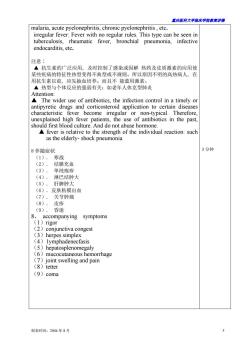
重庆医科大学临床学院载案讲满 malaria,acute pyelonephritis,chronic pyelonephritis,etc. irregular ver Fever with no regular rules This type can be seen in tuberculosis,rheumatic fever,bronchial pneumonia,infective endocarditis,etc. 注音: ▲抗生素的广泛应用,及时控制了感染或因解热药及皮质激素的应用使 些疾病的特征性热型变得不典型或不规则。所以原因不明的高热病人,在 用抗生素以前,应先抽血培养。而且不能滥用激素。 ▲热型与个体反应的强弱有关:如老年人休克型肺炎 Attention The wider use of antibiotics,the infection control in a timely or rugs and cortic roid appl cation to ce ever become irregular or non- -typical Therefore. unexplained high fever patients,the use of antibiotics in the past, should first blood culture.And do not abuse hormone. A fever is relative to the strength of the individual reaction:such as the elderly-shock pneumonia 8伴随症状 3分钟 1 宝战 (2) 结膜充血 (3). 单纯疱寝 (4) 淋四结肿大 5) 肝脾肿大 (6) 皮肤粘膜出血 (7 关节肿痛 (8). 皮老 (9). 昏迷 8、 accompanying symptoms 1)rigor (2)conjunctiva congest (3)herpes (4) ym (5)hepatosp necfasis enomegaly aneous hemorrhage (8)tetter (9)coma 制表时间:2004年8月
重庆医科大学临床学院教案讲稿 制表时间:2004 年 8 月 5 malaria, acute pyelonephritis, chronic pyelonephritis , etc. irregular fever: Fever with no regular rules. This type can be seen in tuberculosis, rheumatic fever, bronchial pneumonia, infective endocarditis, etc. 注意∶ ▲ 抗生素的广泛应用, 及时控制了感染或因解 热药及皮质激素的应用使 某些疾病的特征性热型变得不典型或不规则。所以原因不明的高热病人, 在 用抗生素以前, 应先抽血培养。而且不 能滥用激素。 ▲ 热型与个体反应的强弱有关:如老年人休克型肺炎 Attention: ▲ The wider use of antibiotics, the infection control in a timely or antipyretic drugs and corticosteroid application to certain diseases characteristic fever become irregular or non-typical. Therefore, unexplained high fever patients, the use of antibiotics in the past, should first blood culture. And do not abuse hormone. ▲ fever is relative to the strength of the individual reaction: such as the elderly- shock pneumonia 8 伴随症状 (1). 寒战 (2). 结膜充血 (3). 单纯疱疹 (4). 淋巴结肿大 (5). 肝脾肿大 (6). 皮肤粘膜出血 (7). 关节肿痛 (8). 皮疹 (9). 昏迷 8、 accompanying symptoms (1)rigor (2)conjunctiva congest (3)herpes simplex (4)1ymphadenecfasis (5)hepatosplenomegaly (6)mucocutaneous hemorrhage (7)joint swelling and pain (8)tetter (9)coma 3 分钟
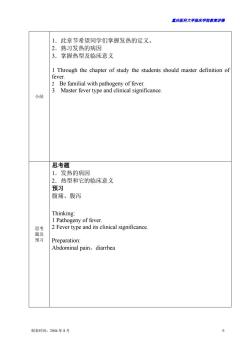
重庆医科大学脑床学院载素讲满 1.此章节希望同学们掌握发热的定义。 2.熟习发热的病因 3. 掌握热型及临床意义 1 Through the chapter of study the students should master definition of fever. 2 Be familial with pathogeny of fever. 3 Master fever type and clinical significance 小结 思考题 1.发热的病因 2.热型和它的临床意义 预习 腹痛、腹泻 Thinking: 1Pathogeny of fever. 思考 2 Fever type and its clinical significance Preparation: Abdominal pain,diarrhea 制表时间:2004年8月
重庆医科大学临床学院教案讲稿 制表时间:2004 年 8 月 6 小结 1.此章节希望同学们掌握发热的定义。 2.熟习发热的病因 3.掌握热型及临床意义 1 Through the chapter of study the students should master definition of fever. 2 Be familial with pathogeny of fever. 3 Master fever type and clinical significance. 思考 题及 预习 思考题 1.发热的病因 2.热型和它的临床意义 预习 腹痛、腹泻 Thinking: 1 Pathogeny of fever. 2 Fever type and its clinical significance. Preparation: Abdominal pain、diarrhea
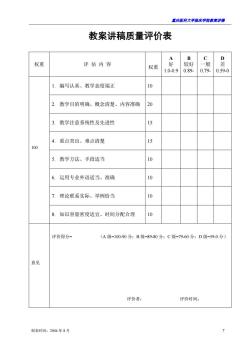
重庆医科大学脑床学院载末讲清 教案讲稿质量评价表 D 权重 评估内容 权重 较好 1.0-0.9 0.89 0.79 0.59-0 编写认真、教学态度端正 10 2教学目的明确、概念清楚、内容准确 20 3.教学注意系统性及先进性 4.重点突出、难点清楚 小 5.教学方法、手段适当 10 6.运用专业外语适当、准确 10 7.理论联系实际、举例恰当 8.知识容量密度适宜、时间分配合理 评价得分= (A级=100-90分:B级=89-80分:C级=79-60分:D级=59-0分) 意见 评价者 评价时间: 制表时间:2004年8月 7
重庆医科大学临床学院教案讲稿 制表时间:2004 年 8 月 7 教案讲稿质量评价表 权重 评 估 内 容 权重 A 好 1.0-0.9 B 较好 0.89- C一般 0.79- D 差 0.59-0 100 1. 编写认真、教学态度端正 10 2. 教学目的明确、概念清楚、内容准确 20 3. 教学注意系统性及先进性 15 4. 重点突出、难点清楚 15 5. 教学方法、手段适当 10 6. 运用专业外语适当、准确 10 7. 理论联系实际、举例恰当 10 8. 知识容量密度适宜、时间分配合理 10 意见 评价得分= (A 级=100-90 分;B 级=89-80 分;C 级=79-60 分;D 级=59-0 分) 评价者: 评价时间:
按次数下载不扣除下载券;
注册用户24小时内重复下载只扣除一次;
顺序:VIP每日次数-->可用次数-->下载券;
- 重庆医科大学:《诊断学》课程教学资源(授课教案)12 血管检查.doc
- 重庆医科大学:《诊断学》课程教学资源(授课教案)15 超声心动图检查.doc
- 重庆医科大学:《诊断学》课程教学资源(授课教案)13 循环系统主要症状与体征.doc
- 重庆医科大学:《诊断学》课程教学资源(授课教案)20 呼吸系统症状和体征.doc
- 重庆医科大学:《诊断学》课程教学资源(授课教案)11 心脏检查.doc
- 重庆医科大学:《诊断学》课程教学资源(授课教案)14 心电图.doc
- 重庆医科大学:《诊断学》课程教学资源(授课教案)06 腹泻.doc
- 重庆医科大学:《诊断学》课程教学资源(授课教案)05 腹痛.doc
- 重庆医科大学:《诊断学》课程教学资源(授课教案)07 黄疸.doc
- 重庆医科大学:《诊断学》课程教学资源(授课教案)02 水肿.doc
- 重庆医科大学:《诊断学》课程教学资源(授课教案)01 绪论与问诊.doc
- 重庆医科大学:《诊断学》课程教学资源(授课教案)08 腹部检查.doc
- 重庆医科大学:《诊断学》课程教学资源(授课教案)09 病历与诊断.doc
- 重庆医科大学:《诊断学》课程教学资源(授课教案)03 呕血.doc
- 重庆医科大学:《诊断学》课程教学资源(授课教案)04 便血.doc
- 重庆医科大学:《实验诊断学》课程教学资源(PPT课件)第八讲 脑脊液常规及生殖系统检查.ppt
- 重庆医科大学:《实验诊断学》课程教学资源(PPT课件)第七讲 大便常规、免疫学检查及心肌标志物检查.ppt
- 重庆医科大学:《实验诊断学》课程教学资源(PPT课件)第六讲 肾功能检查(主讲:唐敏).ppt
- 重庆医科大学:《实验诊断学》课程教学资源(PPT课件)第四讲 血栓与出血检查(主讲:胥文春).ppt
- 重庆医科大学:《实验诊断学》课程教学资源(PPT课件)第三讲 骨髓细胞学检查、血型与输血.ppt
- 重庆医科大学:《诊断学》课程教学资源(授课教案)19 胸部检查.doc
- 重庆医科大学:《诊断学》课程教学资源(授课教案)18 呼吸困难.doc
- 重庆医科大学:《诊断学》课程教学资源(授课教案)16 咳嗽、咳痰.doc
- 重庆医科大学:《诊断学》课程教学资源(授课教案)17 咯血.doc
- 医学临床本科《MRI诊断学》课程教学大纲 Magnetic Resonance Imaging Diagnosis.doc
- 医学临床本科《影像诊断学》课程教学大纲 medical imaging(包含MRI部分).doc
- 医学影像本科《MRI诊断学》课程教学大纲(Magnetic Resonance Imaging Diagnosis).doc
- 石河子大学:《MRI诊断学》课程教学资源(讲稿,共五章).doc
- 石河子大学:《MRI诊断学》课程教学课件(PPT讲稿)第一章 MRI总论.ppt
- 石河子大学:《MRI诊断学》课程教学课件(PPT讲稿)第三章 呼吸系统 3.1 3.2 正常及异常.ppt
- 石河子大学:《MRI诊断学》课程教学课件(PPT讲稿)第三章 呼吸系统 3.3 支气管扩张及肺部炎症.ppt
- 石河子大学:《MRI诊断学》课程教学课件(PPT讲稿)第三章 呼吸系统 3.4 肺结核.ppt
- 石河子大学:《MRI诊断学》课程教学课件(PPT讲稿)第三章 呼吸系统 3.5 肺肿瘤.ppt
- 石河子大学:《MRI诊断学》课程教学课件(PPT讲稿)第三章 呼吸系统 3.6 纵膈疾病.ppt
- 石河子大学:《MRI诊断学》课程教学课件(PPT讲稿)第四章 循环系统(冠脉及主动脉).ppt
- 石河子大学:《MRI诊断学》课程教学课件(PPT讲稿)第五章 消化系统和腹膜腔 5.2 急腹症.ppt
- 石河子大学:《MRI诊断学》课程教学课件(PPT讲稿)第五章 消化系统和腹膜腔 5.3 肝脏.ppt
- 石河子大学:《MRI诊断学》课程教学课件(PPT讲稿)第五章 消化系统和腹膜腔 5.4 胆道系统疾病.ppt
- 石河子大学:《MRI诊断学》课程教学课件(PPT讲稿)第五章 消化系统和腹膜腔 5.5 胰腺.ppt
- 石河子大学:《MRI诊断学》课程教学课件(PPT讲稿)第五章 消化系统和腹膜腔 5.6 脾脏.ppt
